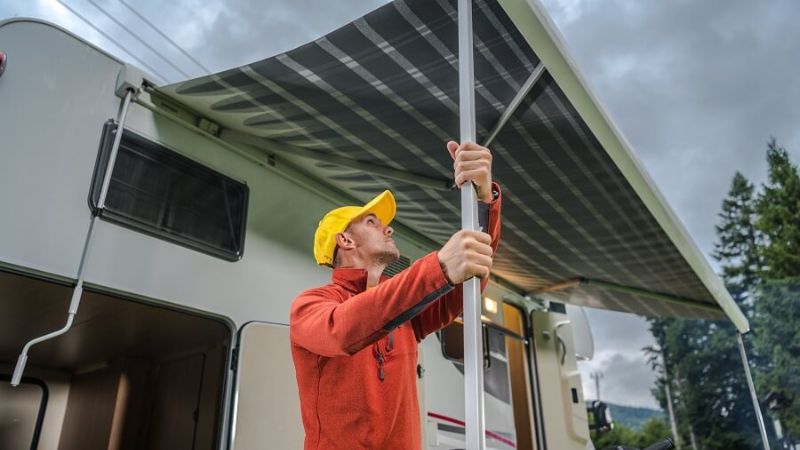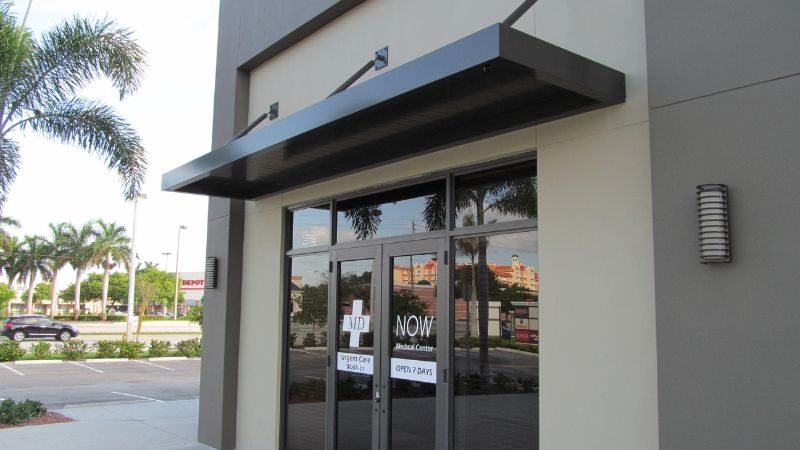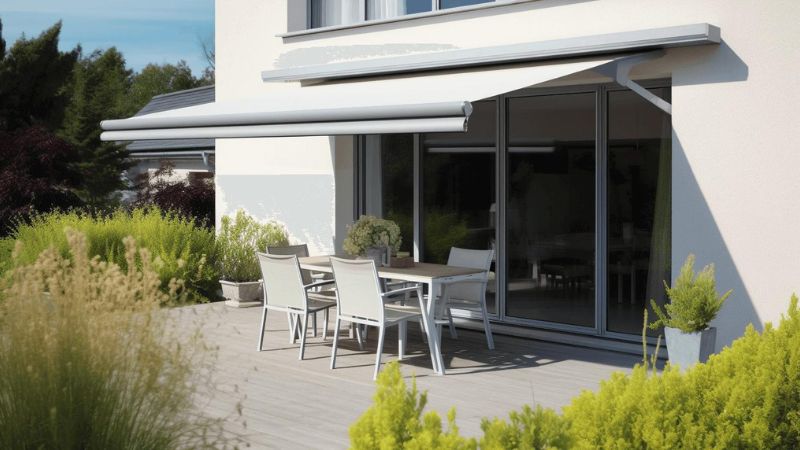Retractable awnings are a fantastic way to add shade and style to your outdoor space, but proper maintenance is key to ensuring their longevity. Without regular care, they can wear down from constant exposure to the elements. This guide offers the 10 best tips on retractable awning maintenance, from cleaning and protecting the fabric to lubricating moving parts. By following these simple steps, you’ll keep your awning looking great and functioning smoothly for years to come, saving on costly repairs and replacements in the future.
10 Best Tips On Retractable Awning Maintenance
1. Clean the Awning Fabric Regularly
One of the most important aspects of retractable awning maintenance is keeping the fabric clean. Over time, dirt, debris, and pollutants can accumulate on the surface, which may cause stains or damage if left unattended.
To clean the fabric, use a soft brush or sponge with mild soap and water. Avoid using harsh chemicals or power washers, as they can weaken the fabric. Rinse thoroughly to remove all soap residue and allow the awning to air dry completely before retracting it. By cleaning it every three to six months, you prevent dirt buildup and maintain the vibrant appearance of your awning.
Also Read:- How To Remove Mould From Canvas Awnings
2. Inspect for Tears or Damage
Regularly inspect your awning fabric for any signs of wear and tear, such as rips, fraying, or holes. Even small tears can grow over time, leading to more significant damage and costly repairs. If you notice any minor issues, patch them immediately using a repair kit designed for awning fabrics.
Most small damages can be repaired quickly if caught early, preventing further degradation. In addition to fabric inspection, check the stitching and seams for any loosening or fraying. Regular inspections, especially after storms or heavy wind, ensure your awning remains structurally sound and visually appealing.
3. Lubricate Moving Parts
Your retractable awning’s mechanical components require regular lubrication to ensure smooth operation. Over time, moving parts such as hinges, arms, and joints can become stiff or corroded, which can lead to difficulty in extending or retracting the awning. Use a silicone-based lubricant or one recommended by the manufacturer to keep these parts functioning properly.
Apply lubrication every six months or after extended periods of inactivity. Avoid using oil-based lubricants, as they can attract dirt and cause build-up. Properly lubricated components reduce the wear on the motor (if your awning is motorized) and extend the lifespan of the entire system.
4. Retract During Severe Weather
Awnings are not designed to withstand extreme weather conditions such as strong winds, heavy rain, or snow. To protect your retractable awning, always retract it during severe weather events. Wind can cause the awning to flap or tear, while heavy rain or snow can accumulate on the fabric and weigh it down, potentially damaging the frame.
By retracting the awning during these times, you prevent unnecessary wear and tear, prolonging its life. Additionally, ensure that the awning is securely fastened when retracted to avoid damage from high winds.
5. Check and Tighten Hardware
The hardware that secures your retractable awning to your home or structure plays a critical role in its stability. Over time, screws, bolts, and brackets can loosen due to vibrations or weather conditions.
Periodically check the hardware to ensure everything is tight and secure. Use a wrench or screwdriver to tighten any loose components, and if any parts appear worn or damaged, replace them promptly. Tight and secure hardware prevents the awning from sagging or becoming unstable, which can lead to safety hazards or further damage.
6. Protect the Awning Fabric
UV rays from the sun can cause the awning fabric to fade over time, especially if it’s exposed to constant sunlight. To protect the fabric from UV damage, consider applying a fabric protector or UV-resistant spray. These products act as a barrier, helping to prevent fading and weakening of the fabric.
Additionally, when the awning is not in use, retract it to reduce sun exposure. This simple step can significantly extend the life of the fabric, keeping it looking fresh and vibrant for years to come.
7. Clear Debris from the Awning
Leaves, twigs, and other debris can accumulate on your awning, especially if it’s near trees or bushes. Over time, this debris can cause the fabric to stretch, sag, or develop mold and mildew. To prevent this, regularly sweep or shake off any debris from the awning.
If your awning is motorized, ensure that it’s clear of any objects before retracting it, as debris can get caught in the mechanism and cause damage. Regularly clearing your awning of debris keeps the fabric taut and prevents long-term issues such as mold growth or material weakening.
8. Use a Protective Awning Cover
When your awning is retracted, it’s a good idea to use a protective cover. This cover helps shield the awning from the elements when it’s not in use, including dust, dirt, and rain. Many manufacturers offer custom-made covers specifically designed for retractable awnings, but you can also use a waterproof tarp that fits snugly around the retracted awning. The cover protects the fabric and mechanical parts from long-term exposure to weather conditions, significantly extending the life of the awning.
9. Avoid Hanging Objects from the Awning
While it may be tempting to hang lights, plants, or decorations from your awning, this practice can put unnecessary strain on the fabric and frame. Retractable awnings are designed to provide shade, not support weight. Hanging objects from the awning can cause it to sag or tear over time, and the extra weight may damage the mechanical components. If you want to decorate your outdoor space, consider hanging lights or plants from other structures, such as walls or pergolas, rather than the awning itself.
Also Read:- Basic Steps of RV Awning Maintenance
10. Schedule Professional Inspections
While regular DIY maintenance is essential, it’s also a good idea to schedule a professional inspection once a year, especially if your awning is motorized. Professionals can identify issues you may have missed and perform necessary repairs to keep your awning in top shape. They can also service the motor, check the alignment of the frame, and make sure the fabric is properly tensioned. Professional maintenance ensures that all aspects of your retractable awning are functioning properly, preventing costly repairs down the line and ensuring a longer lifespan.
Conclusion
Maintaining your retractable awning doesn’t have to be time-consuming or difficult. By incorporating these 10 best maintenance tips into your routine, you can extend the life of your awning and enjoy its benefits all year round. Regular care helps you avoid damage and ensures your outdoor space remains shaded and comfortable. Take the time to protect your investment, and your awning will continue to enhance your home for many seasons to come.
FAQs
How often should I clean my retractable awning?
Cleaning your awning every 3-6 months is recommended, depending on how much exposure it gets to dust, debris, and the elements.
Can I leave my awning out during the winter?
It’s best to retract your awning during winter or heavy storms to protect it from snow and ice buildup, which can cause damage.



